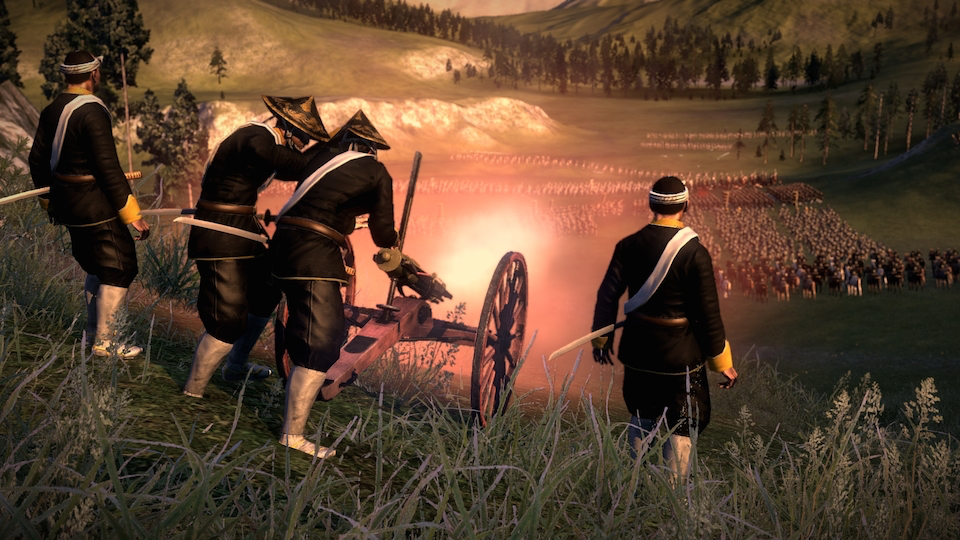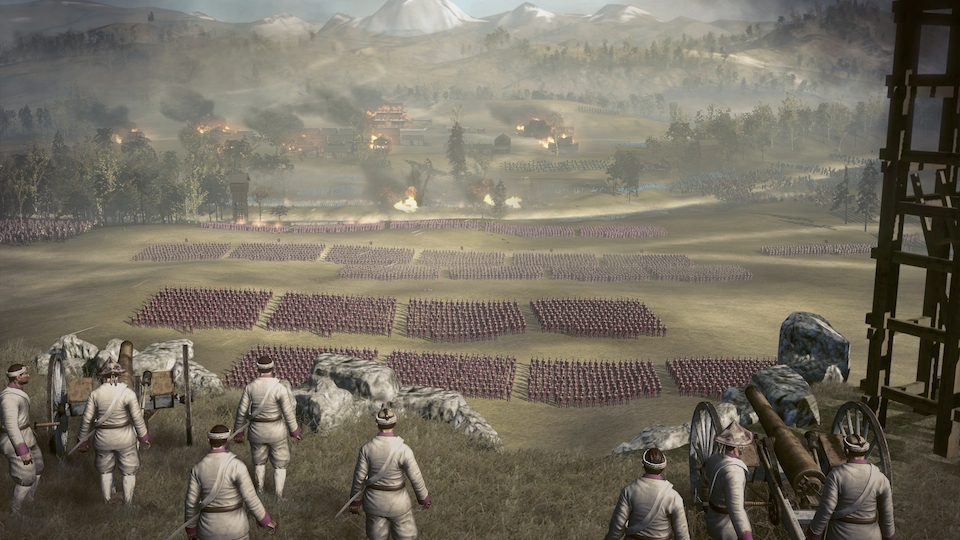By J. Eric Anderson
The 19th century proved to be one of the most turbulent times in the history of the Japanese Empire. After the events of Total War: Shogun 2, Japan enjoyed a prosperous 200 years of peace. That changes with Total War: Fall of the Samurai ($39.99, from Feral Interactive) for Mac OS X 10.9.5 and higher.

Though the emperor had nominal sovereignty, the shoguns held the true power, and were responsible for the meaningful governance of the nation. Seeking to maintain the cultural integrity of Japan, virtually all involvement with the outside world was strictly forbidden; Japanese citizens weren’t allowed to leave the country, and foreigners seeking to enter unbidden were met with violence.
This lasted until an American fleet arrived and forced a trade agreement at gunpoint after bombarding a populous port city. The resulting torrent of foreign technologies and culture was both overwhelming and disturbing to much of the nation. Though both parties feared the destruction of their traditions, factions loyal to the emperor and the shogunate disagreed strongly on how to receive these changes. This led to Imperial forces attempting to restore effective power to the emperor, resulting in the Boshin War.
Following the standard mechanics set-forth in previous Total War titles, Fall of the Samurai takes place on two primary stages: the campaign map, and the battle map. The campaign map is absolutely huge. Japan is split into dozens of different regions, each owned by various rival factions, and home to a unique set of terrain and resources that’ll drastically affect the way you play.

Like in the previous games, there’s an incredible amount of depth, and most of your time will be spent trying to manipulate anything and everything possible to your advantage in your bid to claim Japan. Although all the new features can seem overwhelming at first, the game provides numerous, well-done tutorials and videos that walk players through new concepts, as well as an extensive in-game encyclopedia. These guides are do a great job of helping players make sense of everything without being too obtrusive.
In Fall of the Samurai, your daimyo starts-off supporting either the Imperial or Shogunate factions, the two main forces present in the game. Most of the objectives involve consolidating power for one of these two sides. Accomplishing missions given by your superiors result in increased influence, military support, and cash. However, although working to further the interests of your benefactor is encouraged, players aren’t forced to play solely within this dichotomy. Is one of your neighboring allies preventing you from expanding? Feel free to help yourself to his territory – if, of course, you don’t mind angering a few warlords to do so. You can even strike-out entirely on your own, if you’ve got the guts to do it and feel so inclined.
Adding to the new diplomatic elements, is the drastically increased importance of the navy. The introduction of Western technologies mean that your boats – and those of your enemies – are going to hit harder and at longer ranges than ever before. This newfound firepower gives ships the ability to bombard land-based targets from offshore on both the campaign and battle maps, and has an absolutely devastating effect for those on the receiving end. As a result, naval supremacy isn’t just helpful – it’s downright crucial in your bid to wrest power from your enemies.
And that’s a good thing! I’ll go ahead and admit that I’ve never been a big fan of naval battles in the previous Total War games; they’ve always felt a little too slow and methodical to me. However, the addition of steam-power engines and massive cannons mean that battles aren’t just faster-paced; they’re a lot more fun to watch, too. These sea engagements retain the features that made them successful in the previous games, while adding some new pieces to further improve upon the gameplay.
One of these is the inclusion of an ability to enter the first-person and manually aim and fire their ships’ cannons. Although this isn’t exactly feasible in large-scale engagements where your constantly trying to simultaneously respond to a dozen different actions at once, it does add a much-welcome additional layer of immersion and cinematic quality.

And like all Total War games, a high quality tactical and cinematic experience is exactly what you’ll get throughout the game – especially in the land battles. Fall of the a Samurai stays true to it’s Total War roots in providing a tactical experience that’s deep and rich, while keeping things simple enough that new players can enjoy themselves. As always, battles are massive in scale, with thousands of soldiers fighting on-screen at once.
Where the standalone expansion branches-out from its predecessors in challenging players to learn warfare in a time and place where swords and bows are just as common as guns and cannons. A banzai charge from a group of samurai doesn’t stand a chance against a Gatling gun, but put those troops behind a castle wall, and you’ll be rewarded with an entirely different outcome.
These new dynamics force players to drastically change one’s diplomatic, naval, and land-based strategies from the previous title, while still presenting many familiar challenges. But that’s exactly the point, isn’t it? Total War: Shogun 2: Fall of the Samurai is all about a nation trying to hold fast to its identity while being forced to abruptly adapt to the changes of a modern world. This game leaves these challenges to you. And, I don’t know if you’ll be successful in doing this, I can confidently say that you’ll have a great time trying.
Protect your investment with the Pad & Quill Contega Linen iPad Pro® 9.7 Case
